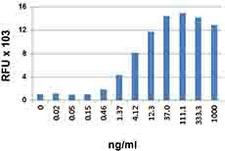order histories, retained contact details for faster checkout, review submissions, and special promotions.
Forgot password?
order histories, retained contact details for faster checkout, review submissions, and special promotions.
Locations
Orders Processing,
Shipping & Receiving,
Warehouse
2 Shaker Rd Suites
B001/B101
Shirley, MA 01464
Production Lab
Floor 6, Suite 620
20700 44th Avenue W
Lynnwood, WA 98036
Telephone Numbers
Tel: +1 (206) 374-1102
Fax: +1 (206) 577-4565
Contact Us
Additional Contact Details
order histories, retained contact details for faster checkout, review submissions, and special promotions.
Forgot password?
order histories, retained contact details for faster checkout, review submissions, and special promotions.
Ccl9 / MIP-1 Gamma
chemokine (C-C motif) ligand 9
Chemokine (C-C motif) ligand 9 (CCL9) is a small cytokine belonging to the CC chemokine family. It is also called macrophage inflammatory protein-1 gamma (MIP-1 gamma), macrophage inflammatory protein-related protein-2 (MRP-2) and CCF18, that has been described in rodents. CCL9 has also been previously designated CCL10, although this name is no longer in use. It is secreted by follicle-associated epithelium (FAE) such as that found around Peyer's patches, and attracts dendritic cells that possess the cell surface molecule CD11b and the chemokine receptor CCR1. CCL9 can activate osteoclasts through its receptor CCR1 (the most abundant chemokine receptor found on osteoclasts) suggesting an important role for CCL9 in bone resorption.[2] CCL9 is constitutively expressed in macrophages and myeloid cells. The gene for CCL9 is located on chromosome 11 in mice.
| Gene Name: | chemokine (C-C motif) ligand 9 |
| Synonyms: | Ccl9, Chemokine (C-C motif) ligand 9, CCF18, MRP-2, Scya9, Scya10 |
| Target Sequences: | NM_011338 NP_035468.1 P51670 |





If you do not find the reagent or information you require, please contact Customer.Support@LSBio.com to inquire about additional products in development.









